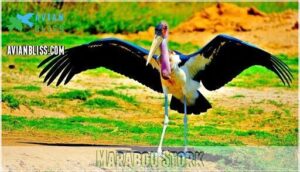This site is supported by our readers. We may earn a commission, at no cost to you, if you purchase through links.
 You’re looking at the wandering albatross as the largest wingspan bird, with wings stretching an incredible 12.2 feet from tip to tip.
You’re looking at the wandering albatross as the largest wingspan bird, with wings stretching an incredible 12.2 feet from tip to tip.
These ocean masters can glide for hours without flapping, riding air currents like feathered sailboats.
While the extinct Pelagornis sandersi once ruled with a jaw-dropping 21-foot wingspan, today’s giants include the great white pelican and southern royal albatross, both topping 11 feet.
The Andean condor and marabou stork round out nature’s heavy hitters at around 10.5 feet.
These massive wings aren’t just for show—they’re perfectly engineered for efficiency, allowing some species to travel thousands of miles while barely breaking a sweat, making them ocean masters, with the ability to ride air currents like feathered sailboats, and showcasing their incredible size.
Table Of Contents
- Key Takeaways
- Birds With Largest Wingspans
- Top 10 Largest Wingspans
- Largest Wingspan Bird Species
- Birds of Prey With Largest Wingspans
- Adaptations for Long-Distance Flight
- Record-Breaking Wingspans
- Bird Flight Capabilities
- Wingspan and Body Size
- Unique Bird Adaptations
- Evolution of Bird Wingspans
- Frequently Asked Questions (FAQs)
- What bird has a 24 foot wingspan?
- Is a condor bigger than a golden eagle?
- Is a condor the biggest flying bird?
- What bird has an 8 foot wingspan?
- Which bird has the largest wingspan?
- Which is the largest bird in the world?
- Which seabird has the largest wingspan?
- What is the biggest bird in the world?
- What are the 10 highest flying birds?
- Is the Andean condor the largest flying bird?
- Conclusion
Key Takeaways
- You’ll find the wandering albatross holds the wingspan record at 12.2 feet – that’s wider than most parking spaces and allows these ocean masters to glide for hours without flapping once.
- Extinct giants like Pelagornis sandersi once dominated with 21-foot wingspans – nearly double today’s largest birds, proving prehistoric skies hosted true aerial monsters that make current champions look modest.
- You can spot dramatic differences between bird types – ocean gliders like albatrosses prioritize massive spans for efficiency, while forest hunters like harpy eagles trade wingspan for maneuverability and stealth.
- These massive wings aren’t just for show but serve as survival tools – they enable species like condors to ride thermals for hundreds of miles while searching for food, turning flight into an energy-saving superpower.
Birds With Largest Wingspans
You’ll discover that nature’s most impressive aerial giants possess wingspans that can stretch over 12 feet, with the wandering albatross claiming the crown for the longest reach.
These magnificent birds have evolved extraordinary wing dimensions that allow them to soar effortlessly across vast ocean distances, making even the largest commercial jets look modest by comparison, which is a truly impressive feat.
Wandering Albatross Wingspan
Among the world’s seabird wingspan champions, you’ll find the wandering albatross reigning supreme with verified measurements reaching 3.7 meters (12.2 feet).
The wandering albatross claims the sky’s throne with wings stretching wider than a school bus
These magnificent albatross species showcase remarkable wingspan variation across populations, with flight efficiency that’s unmatched in avian wingspan records.
Their massive seabird wingspan enables effortless ocean gliding, though habitat influence and conservation status concerns threaten this largest wingspan bird’s future dominance of the skies.
Pelagornis Sandersi Wingspan
Twenty-five million years ago, Pelagornis sandersi ruled prehistoric skies with a staggering 21-foot wingspan—making it the ultimate largest wingspan bird in history.
Ancient giants ruled with 24-foot wingspans that dwarfed today’s champions
Ancient sky-giants ruled with 21-foot wingspans—making today’s largest birds look tiny.
This extinct giant’s Pelagornis size dwarfs today’s wandering albatross, showcasing remarkable flight mechanics through dynamic soaring.
The fossil discovery at Charleston Airport revealed perfectly adapted wings for effortless ocean gliding. Notably, these birds possessed unique salt glands that allowed them to drink seawater.
| Feature | Measurement |
|---|---|
| Maximum wingspan | 24.2 feet |
| Body weight | 48-88 pounds |
| Glide ratio | 22:1 |
Evolutionary context shows these ancient seabirds pushed avian wingspan boundaries beyond what scientists thought possible. Their specialized pseudo-teeth caught slippery prey while soaring thousands of miles.
Bird size comparison reveals P. sandersi’s wingspan exceeded modern albatross species by over 100%—truly nature’s most impressive flying machine.
Comparison of Largest Bird Wingspans
Now you’ll see how these wingspan giants stack up against each other:
- Wandering Albatross – 3.7m wingspan measurements make it the undisputed champion
- Great White Pelican – 3.6m span showcases evolutionary advantages for fishing
- Southern Royal Albatross – 3.5m demonstrates flight efficiency over ocean habitats
- Andean Condor – 3.3m longest wingspan among birds of prey
- Marabou Stork – 3.2m reflects habitat influence on avian wingspan development
These birds often breed on subantarctic islands.
These bird size comparisons reveal conservation concerns for these magnificent species.
Longest Wingspans in Bird Species
You’ll find remarkable wingspan variation among Earth’s largest flying birds.
The wandering albatross claims the longest wingspan record at 12.1 feet, showcasing perfect flight efficiency through ocean winds.
Measurement accuracy matters when comparing avian wingspan – bird size metrics vary by individual and conditions.
Environmental impacts affect these giants differently than smaller species.
While fossil wingspans show extinct birds reached similar sizes, today’s champions master energy conservation through specialized wing designs.
| Bird | Wingspan (Feet) | Habitat |
|---|---|---|
| Wandering Albatross | 12 | Southern Oceans |
| Snowy Albatross | 12.1 | Subantarctic |
| Great Albatross | 11-12 | Open Oceans |
| Marabou Stork | 10.5 | East Africa |
| Andean Condor | 10.5 | Andes Mountains |
Top 10 Largest Wingspans
You’re about to discover the true giants of the bird world, where wingspan determines who rules the skies.
These ten magnificent species stretch their wings to incredible lengths, with some reaching over 12 feet from tip to tip, making them the true rulers of the skies.
Wandering Albatross
Ruling the skies with the largest wingspan of any living bird, the wandering albatross stretches up to 12.1 feet across.
These great albatross masters use dynamic soaring techniques for incredible flight efficiency, gliding thousands of miles without flapping.
You’ll find them patrolling vast ocean habitat areas, where their albatross lifespan can exceed 50 years.
Their plumage variation ranges from pure white to mottled brown, helping scientists track age and breeding status.
Despite their majesty, conservation status remains vulnerable due to fishing threats.
Great White Pelican
You’ll spot the great white pelican soaring across Africa, Europe, and Asia with its remarkable 11.8-foot wingspan.
These social seabirds showcase incredible teamwork while hunting, using synchronized swimming to herd fish into their expandable pouches.
Their conservation status remains stable thanks to protective efforts, though habitat loss poses ongoing challenges.
Key features that make them exceptional:
- Pouch function: Their massive yellow-orange bills expand dramatically to scoop up fish and drain water
- Social behavior: Unlike solitary great albatross species, they hunt cooperatively in coordinated groups
- Habitat range: They thrive in freshwater lakes, wetlands, and coastal areas across three continents
Their pelican diet consists mainly of fish, though they’ll occasionally snatch smaller birds.
While pelagic birds like albatrosses dominate ocean skies, great white pelicans rule inland waterways with grace.
Southern Royal Albatross
You’ll encounter the southern royal albatross soaring across Southern Ocean waters with its impressive 11.5-foot wingspan measurement.
This majestic albatross commands respect through sheer aerial dominance, rivaling the wandering albatross in grandeur.
- Royal Habitat: Breeds exclusively on Campbell Island and Auckland Islands in subantarctic waters
- Breeding Habits: Follows biennial nesting cycles, with pairs returning every two years
- Diet Specifics: Feeds primarily on squid, fish, and krill during extensive oceanic journeys
Their Plumage Details showcase brilliant white bodies contrasting with distinctive black wingtips.
Unfortunately, their Conservation Status remains vulnerable due to limited breeding locations.
Andean Condor
The Andean Condor commands South America’s skies with its massive 10.8-foot wingspan, making it the largest bird of prey.
This South American Icon features a distinctive featherless head that helps maintain hygiene while scavenging.
Despite Habitat Loss threatening populations, Condor Conservation efforts protect this symbol of Andean Symbolism.
These giants showcase remarkable avian wingspans and bird size variations across their range.
Marabou Stork
You’ll find Africa’s ultimate cleanup crew soaring with massive 10.5-foot wingspans. Marabou Storks aren’t just scavengers—they’re ecosystem engineers keeping environments healthy through their unique scavenging role.
These impressive birds showcase remarkable social behavior, gathering in large communal roosts across their stork habitat throughout East Africa.
Their Marabou diet includes:
- Carrion and animal carcasses
- Fish from shallow waters
- Small mammals and reptiles
- Human food scraps and waste
With their distinctive bald heads and massive bills, these 20-pound giants use their exceptional wingspan measurement for effortless soaring. You can spot them gliding on thermals, conserving energy while patrolling vast territories.
Their conservation status remains stable, though habitat loss poses growing concerns for future populations.
Steller’s Sea Eagle
You’ll be amazed by Steller’s Sea Eagle’s massive 7.5-foot wingspan, making it Asia’s largest eagle.
These powerful hunters dominate coastal regions from Russia to Japan, though their Conservation Status remains vulnerable with under 5,000 individuals.
Critical challenges include:
- Habitat Loss: Coastal development threatens nesting sites
- Diet Specifics: Salmon dependency makes them vulnerable to overfishing
- Hunting Techniques: Specialized fishing skills limit adaptability
Trumpeter Swan
You’ll discover the Trumpeter Swan soaring with an impressive wingspan reaching up to 10 feet.
These magnificent birds rank among North America’s heaviest flying species, with some individuals tipping the scales at 33 pounds – nearly double a Mute Swan’s bird weight.
Their substantial size enables remarkable Swan Migration journeys across thousands of miles.
Their powerful Vocalizations can carry for miles, earning them their musical name.
Unlike the quieter Whooper Swan, trumpeters announce their presence with bold, bugling calls.
Trumpeter Habitat centers around pristine wetlands, where these graceful giants perform elaborate Mating Rituals that include synchronized swimming and neck arching.
Swan Conservation efforts focus on protecting their wetland homes, as habitat loss threatens this recovering bird species.
These devoted partners mate for life, raising cygnets together for decades.
Secretarybird
You’ll spot the Secretarybird strutting across African savannas with its impressive 2.1-meter wingspan.
This unique African raptor dominates terrestrial hunting through specialized leg morphology, delivering powerful stomping strikes for snake predation.
Its flight adaptations balance soaring capability with ground-based prowess.
- Long legs stomping through grasslands like nature’s own pest control expert
- Distinctive crest feathers flowing as it surveys the savanna landscape
- Powerful wings spreading wide during territorial displays and hunting flights
Dalmatian Pelican
With its massive 11.5-foot wingspan, the Dalmatian Pelican (Pelicanus crispus) dominates freshwater birds across Europe and Asia.
You’ll recognize this giant by its curly nape feathers and distinctive orange breeding bill.
Unlike the Great White Pelican, Dalmatian Pelicans prefer freshwater habitat over coastal areas.
Their diet adaptations focus on large fish, while conservation status remains vulnerable due to habitat loss threatening their breeding habits.
Blakistons Fish Owl
You’ll find Blakiston’s Fish Owl claiming the tenth spot with its impressive 1.9-meter wingspan. This nocturnal powerhouse inhabits Russia and Japan’s forested wetlands, where its exceptional Nocturnal Behavior makes it a formidable hunter.
The Fish Owl Diet consists primarily of salmon and trout, which it snatches with surgical precision along riverbanks. Unfortunately, this magnificent bird species faces a vulnerable Conservation Status due to habitat destruction threatening its survival.
Key characteristics include:
- Owl Habitat: Pristine riverine forests across East Asia
- Owl Size: Weighs up to 4.6 kg with distinctive feathered ear tufts
- Bird morphology: Powerful talons perfectly adapted for aquatic prey
- Bird behavior: Silent flight combined with patient ambush tactics
- Avian diversity: Represents the world’s largest owl species
Largest Wingspan Bird Species
When you’re looking at the world’s largest flying birds, you’ll discover that wingspan measurements reveal fascinating differences between species and their flight adaptations.
The wandering albatross claims the top spot with wingspans reaching up to 12.2 feet, but several other giants like great white pelicans and Andean condors aren’t far behind in this aerial size competition.
Characteristics of Albatrosses
You’ll encounter these magnificent seabirds mastering ocean winds with unmatched grace.
Albatrosses boast the longest wingspan among living birds, with wandering albatross reaching 12.1 feet.
Their Albatross Plumage features distinctive black-and-white patterns perfect for oceanic life.
These seabirds inhabit remote Albatross Habitat areas across southern oceans, where their specialized Albatross Diet consists of squid, fish, and krill.
Royal albatross species demonstrate remarkable Albatross Lifespan, living over 60 years.
Unfortunately, Albatross Conservation efforts are essential as these aerial giants face threats from fishing practices and climate change affecting their pristine breeding grounds.
Trait Feature Remark
Unique Features of Condors
You’ll recognize condors as nature’s ultimate cleanup crew, with their featherless heads perfectly adapted for Condor Scavenging without messy plumage.
These magnificent vultures dominate their Andean Habitat through incredible soaring abilities, riding thermals for hours without flapping.
- Featherless Head design prevents bacteria buildup while feeding on carrion
- Social Behavior includes lifelong partnerships and communal roosting sites
- Massive wingspan enables effortless gliding across mountain ranges for miles
Both Andean condor and California condor face serious Conservation Status challenges, making protection efforts essential for these soaring giants’ survival.
Distinguishing Traits of Storks
You’ll recognize stork morphology by their towering legs and dagger-like beaks, perfectly designed for their stork diet of fish, amphibians, and carrion.
The Marabou Stork (Leptoptilos crumenifer) exemplifies stork behavior through its scavenging prowess, while Jabiru Storks dominate wetland stork habitats.
These adaptable storks face stork conservation challenges, yet their specialized anatomy keeps them thriving across diverse ecosystems.
Comparison of Bird Species Wingspans
Across species, wingspan variation tells nature’s flight story perfectly.
You’ll discover remarkable differences that showcase evolutionary advantages and environmental impacts on bird development.
Here’s how these giants compare:
- Wandering albatross – 12.1 feet maximum for ocean mastery
- Great white pelican – 11.8 feet for coastal efficiency
- Southern royal albatross – 11.4 feet for subantarctic conditions
- Andean condor – 10.8 feet for mountain thermals
- Trumpeter swan – 10 feet for wetland navigation
Measurement discrepancies occur between studies, but patterns remain clear.
Bird species comparison reveals that avian wingspans directly correlate with habitat demands.
Flight efficiency drives these differences—ocean gliders need maximum span while forest dwellers require maneuverability over size.
Birds of Prey With Largest Wingspans
You’re about to meet the birds of prey with the widest wingspans, from the soaring Andean condor to the tall Secretarybird.
These raptors aren’t just impressive hunters—they’ve got wings so big, they could almost double as gliders in a science class experiment.
Andean Condor Wingspan
You’ll witness the Andean condor’s impressive 10.5-foot wingspan dominating South American skies.
This magnificent vulture masters thermal soaring across mountainous terrain, utilizing its massive wings for efficient scavenging behavior throughout the Andean habitat.
Their conservation status remains vulnerable, making these culturally significant birds precious symbols of power.
You can find a Condor Wingspan Model for educational purposes.
- Condor flight mechanics: These vultures can soar for hours without flapping, riding thermals with remarkable energy efficiency
Harpy Eagle Wingspan
You’ll find the harpy eagle’s wingspan measures just 6.5 feet, but don’t let that fool you.
This powerhouse compensates with incredible Harpy Size and specialized Feather Structure that enables silent flight through dense Eagle Habitat.
Its unique bird wing structure supports precise bird flight mechanics during lightning-fast ambushes on sloths and monkeys.
The harpy’s Hunting Style relies on stealth over span, making it a formidable apex predator despite its modest wingspan compared to other raptors.
The eagle’s impressive dimensions contribute to its hunting prowess.
Unfortunately, its Conservation Status remains vulnerable.
Secretarybird Wingspan
You’ll spot the secretarybird’s impressive 6.9-foot wingspan across Africa’s savannas, but this terrestrial raptor breaks every rule.
Unlike soaring raptors, it stomps snakes to death with powerful legs rather than swooping from above. Its hunting adaptations include ground-based pursuit and lightning-quick strikes.
Secretarybird flight serves mainly for escaping danger and traveling between territories. These unique bird adaptations showcase evolution’s creativity—trading aerial mastery for terrestrial dominance.
With stable conservation status throughout its habitat range, this remarkable wingspan supports both brief flights and intimidating threat displays during ground encounters.
Comparison of Bird of Prey Wingspans
When comparing bird of prey wingspans, you’ll notice dramatic differences shaped by hunting strategies.
The Andean condor dominates at 10.8 feet, while California condor reaches 10.2 feet.
Vulture wingspans excel at soaring, eagles pack power into shorter spans, and falcon flight prioritizes speed over size.
Here’s how raptors stack up:
- Andean Condor: 10.8 feet – ultimate soaring machine
- California Condor: 10.2 feet – North America’s giant
- Steller’s Sea Eagle: 8 feet – powerful coastal hunter
- Golden Eagle: 7.8 feet – mountain master
- Harpy Eagle: 6.8 feet – forest specialist
Raptor gliding efficiency increases with wingspan, explaining why scavenging condors dwarf hunting eagles.
Adaptations for Long-Distance Flight
You’ll discover that birds with massive wingspans have evolved remarkable adaptations that let them soar for hours without flapping their wings once.
These giants use thermal currents and air pressure differences like nature’s own escalators, turning long-distance travel into an effortless glide that would make any frequent flyer jealous.
Gliding Flight Techniques
When birds master the art of staying aloft without constant flapping, they’re using soaring mechanics that would make any pilot jealous.
The wandering albatross perfects this technique, using its specialized wing morphology to lock wings in place while riding air currents.
These albatrosses can glide for hours at ideal gliding altitude, where environmental factors like wind speed create perfect conditions.
Their incredible energy efficiency comes from understanding air patterns – they’re basically living flight computers that never need to recharge.
Thermal Soaring in Scavengers
Three massive scavengers—Andean condor, Cinereous Vulture, and Lappet-faced Vulture—master thermal soaring like aerial pros.
You’ll witness these giants riding warm air currents, covering hundreds of miles without flapping once.
Their thermal dependence isn’t weakness; it’s brilliant evolutionary engineering that maximizes scavenger efficiency while conserving precious energy.
- Soaring advantages: Ride thermals for hours with minimal wing beats
- Flight adaptations: Wide wings perfectly designed for catching rising air
- Evolutionary pressures: Energy conservation shaped their massive wingspan development
- Scavenger efficiency: Cover vast territories searching for carrion effortlessly
Conservation of Energy in Flight
Master soaring efficiency through wing morphology that’s perfectly tuned for endurance.
You’ll witness how massive wingspans reduce metabolic rates by 90% during flight.
These aerial giants exploit thermal exploitation and dynamic soaring, transforming wind energy into forward momentum.
Smart migration strategies minimize flapping—albatrosses can glide for hours without a single wingbeat.
Their bird flight adaptations create incredible bird energy efficiency, allowing 75,000-mile journeys on minimal fuel.
Nature’s bird soaring performance makes jet engines look wasteful by comparison.
Unique Features of Pelagic Birds
Exploring oceanic life, wandering albatross and other pelagic seabirds display remarkable oceanic adaptations.
Their specialized salt gland removes excess salt from seawater, while advanced navigation skills guide epic migrations.
These seabirds use intelligent foraging strategies, covering vast distances with waterproof plumage adaptations.
- Salt tolerance lets them drink seawater without dehydration
- Epic migrations span thousands of miles across open ocean
- Effortless soaring using massive wingspans to ride wind currents
- Specialized foraging techniques maximize energy from marine prey
Record-Breaking Wingspans
You’ll discover wingspan records that stretch the limits of what seems possible in the bird world.
From the wandering albatross’s confirmed 12.2-foot span to extinct giants like Pelagornis sandersi that may have reached 24 feet, these measurements reveal how evolution pushed flight to extraordinary extremes, showing the extremes of what is possible in nature.
Largest Wingspan Ever Recorded
When you witness nature’s aerial champions, wandering albatrosses claim the crown with verified maxima reaching 3.7 meters (12.2 feet).
These measurement contexts reveal fascinating population variation across oceanic regions.
Historical records document these giants alongside other contenders:
- Wandering Albatross: 12.2 ft verified wingspan
- Southern Royal Albatross: 11.5 ft documented span
- Great White Pelican: 11.8 ft maximum reach
- Dalmatian Pelican: 11.5 ft recorded wingspan
While unverified claims suggest larger specimens exist, scientists rely on documented bird wingspan records for accuracy.
These birds’ wingspans are essential in defining their flight and aerodynamics.
Comparison of Extinct and Living Bird Wingspans
Ancient sky-giants make today’s largest flying birds look like toys. Fossil wingspans reveal that extinct giants like Pelagornis sandersi stretched an incredible 21 feet across—nearly double the wandering albatross’s 12-foot span.
These prehistoric ocean-gliders dominated ancient seas with wings built for effortless soaring.
Size discrepancies between extinct and living species tell evolution’s story. Avian evolution traded massive size for practical advantages: better agility, faster takeoffs, and improved energy efficiency.
Modern birds can’t match ancient wingspans, but they’ve mastered flight biomechanics that their giant ancestors couldn’t achieve.
Evolutionary trends show nature’s brilliant compromise—today’s largest flying birds sacrificed size for survival skills.
Factors Influencing Wingspan Evolution
While environmental pressures shape wingspan evolution, you’ll discover that flight efficiency drives most changes.
Natural selection favors birds that can soar longer distances using less energy – just look at the wandering albatross mastering ocean winds.
Genetic drift adds random variations, while sexual selection rewards impressive displays.
Prey size also matters; larger targets need stronger wings.
Here are three key evolutionary forces that’ll blow your mind:
- Energy conservation – Birds with efficient wings survive harsh migrations
- Mating success – Bigger wingspans often mean better courtship displays
- Food accessibility – Wider wings reach more feeding areas
These evolutionary pressures created today’s aerial giants through millions of years of avian evolution.
Bird Flight Capabilities
You’ll notice that birds with the biggest wingspans aren’t just showing off—they’ve evolved specialized flight techniques for crossing oceans, soaring over mountains, and gliding with minimal effort.
If you’ve ever wondered how an albatross can stay airborne for days, or why a condor barely flaps its wings, it’s all about the physics of wingspan and the clever ways birds use air currents.
Relationship Between Wingspan and Flight
You’ll find that wingspan acts as nature’s flight blueprint, determining how each bird conquers the skies.
Flight efficiency peaks with longer wings—albatrosses master effortless ocean gliding, while shorter wings favor quick maneuvers.
Wingspan loading reveals this balance: heavy birds need larger wings for lift.
Soaring ability improves with span, enabling thermal riding and migration patterns spanning continents.
These evolutionary advantages showcase how wing design perfectly matches each species’ flight capabilities.
Factors Affecting Bird Flight
Bird flight depends on several interconnected factors that work together like a finely tuned machine.
You’ll find that successful flight requires the perfect balance of physics and biology working in harmony.
Here are the key factors that determine flight efficiency:
- Wing loading – the ratio of body weight to wing area affects takeoff and maneuverability
- Airfoil shape – curved wing profiles create lift by directing airflow above and below
- Feather structure – lightweight yet strong feathers provide flexible control surfaces
- Muscle power – strong pectoral muscles generate the force needed for sustained flight
- Flight efficiency – streamlined bodies reduce drag while maximizing lift generation
These elements explain why wandering albatrosses excel at ocean gliding while condors master mountain thermals.
Bird flight patterns emerge from how these factors combine, creating the diverse bird flight capabilities we observe across species with varying wing shapes and flight efficiency adaptations.
Comparison of Bird Flight Techniques
Flight techniques vary dramatically across wingspan categories, giving you a front-row seat to nature’s engineering marvels.
Large wingspan masters like albatrosses showcase Efficient Gliding and Dynamic Soaring, riding ocean winds for thousands of miles without flapping. Meanwhile, powerful condors exploit Thermal Utilization for effortless soaring over mountains.
Here’s how bird flight patterns break down:
- Soaring vs. Flapping: Condors use thermals while hummingbirds rely on rapid wing beats
- Migration Strategies: Albatrosses glide across oceans using bird flight dynamics
- Hovering Precision: Raptors combine flight capabilities with hunting accuracy
Each technique reflects millions of years perfecting bird flight efficiency.
Wingspan and Body Size
You’ll discover that wingspan doesn’t always match body weight, creating some surprising mismatches in the bird world.
A lightweight wandering albatross can stretch its wings wider than a much heavier condor, proving that nature’s engineering follows different rules than you might expect.
Relationship Between Wingspan and Body Size
You’ll notice wingspan isn’t just about raw size—it’s about weight distribution and flight efficiency working together like a perfectly tuned engine.
A bird’s skeletal structure must support massive wings while staying light enough for takeoff. Muscle mass powers those wings, but too much bulk kills performance. Bird bone density stays hollow yet strong, while habitat influence shapes these proportions over millions of years.
| Species | Wingspan (ft) | Body Weight (lbs) |
|---|---|---|
| Wandering Albatross | 12.1 | 26 |
| Andean Condor | 10.8 | 33 |
| Trumpeter Swan | 10.0 | 33 |
| Marabou Stork | 9.5 | 20 |
Bird weight constraints force nature’s ultimate balancing act—bigger isn’t always better when you’re defying gravity.
Comparison of Bird Body Sizes
When examining wingspan records, you’ll notice remarkable bird body weight variations that defy expectations.
Despite their massive span, Weight vs. Wingspan ratios reveal surprising efficiency patterns across species.
- Weight vs. Wingspan: Albatrosses achieve 12-foot spans while weighing just 26 pounds
- Sexual Dimorphism Size: Female raptors consistently outweigh males by 20-50%
- Diet and Size: Carnivorous birds develop heavier builds than fish-eating specialists
- Habitat Influence Size: Open-ocean species prioritize span over bulk for efficient gliding
Factors Influencing Bird Body Size
Several factors shape bird body size beyond wingspan measurements. Dietary influence determines growth potential—protein-rich diets support larger frames. Genetic factors control maximum size limits, while sexual selection often produces dimorphic species where males outweigh females.
Habitat impact and climate change create environmental pressures affecting bird body weight. Resource scarcity constrains growth, forcing efficiency trade-offs between size and survival.
| Factor | Small Birds ( 5kg) | |
|---|---|---|
| Dietary Influence | Seeds, insects | Fish, carrion, mammals |
| Habitat Impact | Dense forests | Open oceans, plains |
| Genetic Factors | Fast metabolism | Slow growth rates |
| Climate Adaptation | Heat loss concern | Cold tolerance |
| Sexual Selection | Minimal dimorphism | Pronounced size differences |
Understanding bird size implications helps explain why bird physiological properties vary dramatically. These bird ecological properties demonstrate nature’s remarkable adaptation strategies.
Unique Bird Adaptations
You’ll find that these massive birds have evolved incredible adaptations that go far beyond just impressive wingspans.
From the Marabou Stork’s scavenging prowess to the Harpy Eagle’s silent hunting skills, each species has developed unique features that help them thrive in their specific environments, showcasing their incredible adaptations.
Marabou Stork Adaptations
Beyond wingspan measurements lies the Marabou Stork’s remarkable survival toolkit. You’ll find this African giant perfectly equipped for its messy lifestyle through brilliant evolutionary design.
Scavenging Behavior drives every adaptation. The stork’s bald head isn’t just for looks—it’s nature’s built-in sanitation system. When you’re digging into rotting carcasses, feathers would trap deadly bacteria. Smart design beats fashion every time.
Disease Resistance sets this bird apart from delicate albatross family members. While other scavengers might succumb to toxins, the Marabou’s iron stomach processes lethal bacteria like a biological waste treatment plant.
Bill Adaptations create the perfect multipurpose tool—strong enough to tear flesh yet precise enough for delicate tasks. Meanwhile, Leg Morphology provides stability in wetlands where other birds would struggle.
Social Hierarchy within colonies prevents chaos during feeding frenzies. This ecological niche demands cooperation among fierce competitors. Their beaks are a prime example of specialized beak adaptations.
Key adaptations include:
- Bald head prevents bacterial contamination
- Inflatable throat pouch for temperature regulation
- Powerful digestive system neutralizes pathogens
- Long legs navigate challenging wetland terrain
- Established pecking order maintains group stability
Harpy Eagle Adaptations
You’ll marvel at the Harpy Eagle’s incredible talons strength – they grip with 530 pounds of pressure, crushing bones effortlessly.
Their camouflage plumage creates perfect habitat specialization, blending seamlessly into rainforest shadows.
These apex predators showcase remarkable bird anatomy with broad, rounded bird wing shapes optimized for traversing dense canopies.
Understanding avian skeletal structure can further illuminate these adaptations.
Their silent hunting techniques and dedicated parental care demonstrate how wingspan and specialized bird flight patterns make them rainforest royalty among bird species characteristics.
Cassowary Adaptations
Flightless cassowaries pack serious evolutionary punch in Australia’s rainforests.
You’ll find these magnificent birds sporting incredible Defense Mechanisms that’d make any predator think twice.
Their Habitat Adaptations shine through remarkable features:
- Razor-sharp claws slice through dense undergrowth like nature’s machetes
- Helmet-like casques bulldoze through tangled vegetation with unstoppable force
- Jet-black Plumage Features provide perfect camouflage in shadowy forest floors
- Powerful legs deliver bone-crushing kicks at lightning speed
Their Cassowary Diet focuses on fruit dispersal, making them rainforest architects.
Unlike seabirds requiring albatross conservation efforts, these land giants thrive through pure intimidation.
Emperor Penguin Adaptations
You’ll discover that emperor penguins have mastered Cold Climate Survival through remarkable Feather Insulation—multiple layers trap warm air like nature’s down jacket.
Their Diving Physiology lets them plunge 1,800 feet, holding their breath for 22 minutes while hunting fish.
Social Behavior becomes their superpower during Antarctic winters, huddling together and rotating positions to share warmth.
Their Breeding Strategies showcase incredible teamwork—males balance eggs on their feet for two months while females hunt.
These flightless birds prove that avian biology doesn’t always require soaring through skies.
Evolution of Bird Wingspans
You’ll discover how millions of years shaped the incredible wingspans we see today, from ancient giants like Pelagornis sandersi with its 24-foot span to modern champions like the wandering albatross.
Evolution crafted these aerial architects through survival pressures that favored efficient gliding, long-distance travel, and energy conservation over vast oceans and continents.
Evolutionary Pressures on Bird Wingspans
Understanding bird wingspan evolution reveals nature’s engineering at work.
Four major evolutionary pressures shape these magnificent flight tools:
- Migration demands drive longer, more efficient wings for endurance flights
- Habitat influence creates shorter wings in forests, longer spans in open areas
- Predation effects favor quick-escape designs versus soaring efficiency
- Energetic costs of large wingspans balance flight efficiency against maneuverability needs
Flight efficiency becomes essential when crossing oceans or continents.
Fossil records show how wing design adapted over millions of years, with bird flight evolution reflecting bird evolution constraints.
Climate change now accelerates these ancient patterns, proving wingspan isn’t just about size—it’s survival’s blueprint.
Comparison of Bird Wingspan Evolution
Countless species showcase how wingspan selection drives evolutionary success through environmental pressures and genetic drift.
You’ll find that flight efficiency shapes wing anatomy over millions of years, with the fossil record revealing fascinating adaptations.
Bird evolution demonstrates how different lineages developed specialized wingspans for their unique lifestyles and habitats.
Bird adaptations like hollow bones aided flight.
- Ocean gliders: Albatrosses evolved massive spans for effortless soaring across vast distances
- Thermal riders: Vultures developed broad wings to catch rising air currents efficiently
- Mountain soarors: Condors adapted wide wingspans for traversing mountainous terrain with minimal energy
- Speed specialists: Swifts evolved compact wings for rapid, agile flight patterns
Unique Features of Bird Wingspans
You’ll find bird wingspans pack incredible engineering secrets. Each wing tells its own aerodynamic story—like how the Southern Royal Albatross masters dynamic soaring with its 12-foot span, riding Aerodynamic Forces for thousands of miles without a single wingbeat.
Aspect Ratio separates the pros from amateurs. High aspect ratios mean narrow, efficient wings that slice through air like butter. Think albatross versus eagle—one’s built for marathon ocean crossings, the other for quick forest navigation.
Wing Loading matters too. Heavy birds need bigger wings or they’ll drop like stones. Feather Structure completes the picture: stiff primary feathers lock in for soaring, while flexible secondaries adjust for perfect Flight Efficiency. Nature’s bird wing anatomy proves that size isn’t everything—it’s how you use those wings that counts in bird flight mastery.
Frequently Asked Questions (FAQs)
What bird has a 24 foot wingspan?
You’d need a time machine to find a bird with a 24-foot wingspan.
No living bird comes close—the wandering albatross tops out at 2 feet, making your question twice as ambitious.
Is a condor bigger than a golden eagle?
Yes, you’ll find condors dwarf golden eagles in both wingspan and weight.
Andean condors reach wingspans up to 10 feet 10 inches, while golden eagles max out around 5 feet—condors rule the skies.
Is a condor the biggest flying bird?
Picture a wandering albatross soaring effortlessly over Antarctic waters with wings spanning twelve feet—that’s your wingspan champion.
While condors are massive, impressive birds, they’re not the biggest flyers.
Wandering albatrosses hold that record with their incredible reach.
What bird has an 8 foot wingspan?
You’ll find several birds sporting 8-foot wingspans, including the Kori bustard, secretarybird, and Steller’s sea eagle. These impressive fliers demonstrate nature’s engineering prowess in different habitats worldwide.
Which bird has the largest wingspan?
Like a glider stretching its arms to catch every thermal, you’ll discover the wandering albatross reigns supreme with wingspans reaching up to 2 feet—nature’s ultimate soaring champion.
Which is the largest bird in the world?
When you’re talking about "largest bird," it depends on what you mean. The wandering albatross claims the wingspan crown at 12 feet, while ostriches rule height and weight.
Which seabird has the largest wingspan?
While you might think all large seabirds have similar wingspans, the wandering albatross dominates with wings stretching up to 12 feet across—that’s wider than most car lengths and easily beats other seabirds.
What is the biggest bird in the world?
You’ll encounter different "biggest" claims depending on criteria. The wandering albatross dominates wingspan at 12+ feet, while the Andean condor‘s your heavyweight champion, weighing up to 33 pounds with impressive 11-foot spans.
What are the 10 highest flying birds?
One Rüppell’s vulture reached 37,000 feet – higher than Mount Everest after colliding with an airliner.
These birds are known for high-altitude flights that are rarely observed.
You’ll find the top ten include Bar-headed Goose, Common Crane, Whooper Swan, Alpine Chough, Bearded Vulture, Black Kite, Andean Condor, Mallard, Bar-tailed Godwit, and White Stork.
Is the Andean condor the largest flying bird?
No, you’re mistaken about the Andean condor being the largest flying bird.
While it’s impressively large with a 10-foot wingspan, the wandering albatross actually claims that title, soaring with wings spanning up to 12 feet.
Conclusion
Remarkably, the wandering albatross can lock its wings in place and glide for over 600 miles without a single wingbeat.
You’ve discovered nature’s most impressive aerial architects, from the record-holding wandering albatross to the extinct giants like Pelagornis sandersi.
These largest wingspan bird champions showcase millions of years of evolutionary perfection, turning massive wings into efficient flying machines.
Whether you’re watching condors ride thermals or pelicans cruise coastlines, you’re witnessing engineering that humans can barely replicate with modern technology, a testament to nature’s most impressive aerial architects and their ability to achieve efficient flying machines.
























